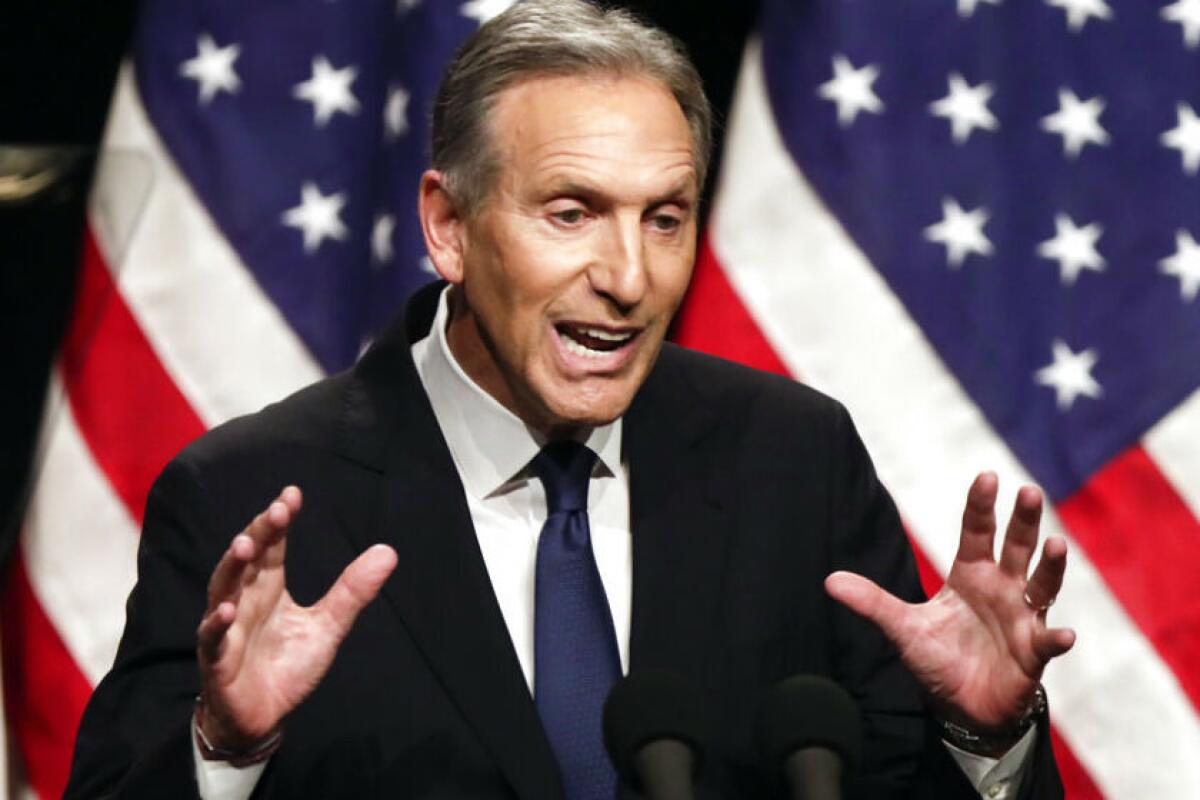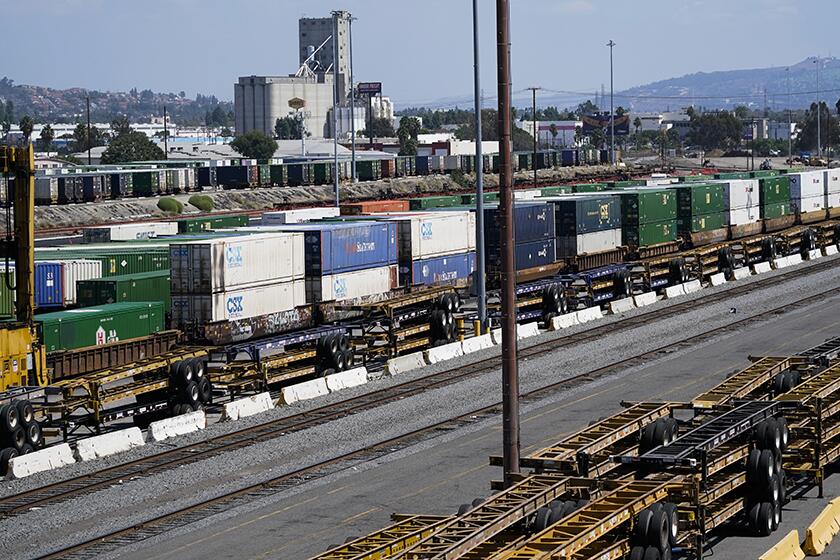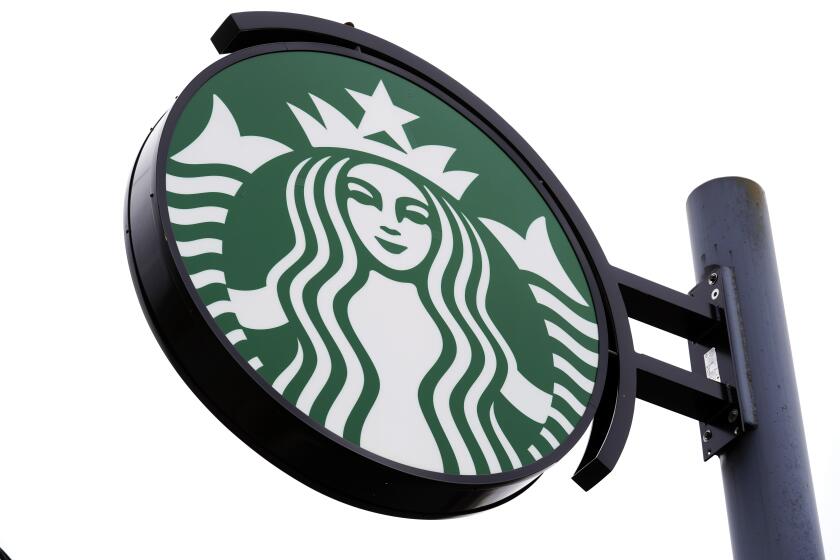Column: How touchy-feely Starbucks became the poster child for illegal union-busting

- Share via
Few American companies strive to project as warm and welcoming an image as Starbucks, in its treatment of customers and workers alike.
That may have ended with a ruling last week by a National Labor Relations Board judge, who cited the coffeehouse chain for “hundreds of unfair labor practices” amounting to “egregious and widespread misconduct demonstrating a general disregard for the employees’ fundamental rights.”
Administrative Law Judge Michael Rosas’ ruling related to the company’s response to an organizing drive by Starbucks Workers United, an affiliate of the Service Employees International Union, in Buffalo, N.Y.
Starbucks is the poster child of union-busting in the United States.
— Starbucks Union official Gary Bonadonna Jr.
That region became the epicenter of a movement that has now held successful union votes at 289 of the company’s roughly 9,000 locations.
One would have to look far and wide for as uncompromising a condemnation of union-busting as the 218-page ruling issued March 1 by Rosas, or the extraordinary remedies he ordered from the company.
Get the latest from Michael Hiltzik
Commentary on economics and more from a Pulitzer Prize winner.
You may occasionally receive promotional content from the Los Angeles Times.
These include mandates that Starbucks rehire scores of Buffalo-area workers Rosas found to have been fired for union activities, restoring back pay to many more whose hours were cut, allegedly for participation in or support of the unionization drive, and the reopening of at least one location allegedly shuttered to hobble unionization.
Most remarkably, Rosas ordered Chief Executive Howard Schultz and Denise Nelson, the company’s senior vice president for U.S. operations, to read out (or have it read out in their presence) a 13-page statement detailing workers’ unionization rights, all the ways they were violated and all the remedies he specified.
The notice must also be posted in every Starbucks store where it can be seen by employees, whom the company invariably describes as “partners.”
This is strong medicine for Schultz, who is in his third stint as CEO. (He’s stepping down from that role this month but will remain on the board.) After resisting an invitation to appear before the Senate Health, Education, Labor and Pensions Committee, Schultz agreed to appear when committee Chair Bernie Sanders (I-Vt.) threatened to seek a subpoena. Schultz’s testimony is scheduled for March 29.
Noncompete clauses push down wages and trap workers in lousy jobs, so of course they’re beloved by employers. The FTC wants to change that.
The company has maintained that Schultz hasn’t been involved in union issues at Starbucks, but that’s nonsense. The anti-union stance at Starbucks must be laid at his door. As we reported in April, after becoming “interim CEO” in March 2022 he made himself the face and voice of the company’s ferocious counterattack on the unionization drive.
Schultz appeared in videotaped town hall presentations and put his name to written communications to workers and managers. There and in group meetings with workers around the country, he repeatedly characterized unions as a menace to the company’s economics and culture.
“Outside labor unions are attempting to sell a very different view of what Starbucks should be,” he wrote in an open letter posted on the company’s website April 10. Employees “supporting unionization are colluding with outside union forces. ... I do not believe conflict, division and dissension — which has been a focus of union organizing — benefits Starbucks or our partners.”
Starbucks has also hired Littler Mendelson, a law firm that boasts of guiding companies “in developing and initiating strategies that lawfully avoid unions.”
These include advising management on “precise and compliant messaging to employees ... that may include informational signs and posters, home letters, meeting materials, testimonial videos, social media postings, handouts and campaign websites.”
Rosas’ ruling is subject to review by the National Labor Relations Board, which has a Biden-appointed Democratic majority and a Biden-appointed general counsel, a powerful administrative post, after years in which it was under the sway of a worker-hostile Trump majority and general counsel.
The order can be appealed by Starbucks, which has said it will seek to “obtain further legal review.” Rosas’ ruling applies to 20 Buffalo-area locations and one in Rochester, N.Y.
The rail strike is looming because the railroads are refusing to give their workers paid sick days, even though they are swimming in profits. Congress should let workers use their leverage.
What’s fascinating about the ruling is how the judge laid out the road map of methods, from subtle to naked, followed by employers determined to bust unions in the modern age. Many of these are disguised as agreeable efforts to foster cooperation and collaboration between management and employees, but they’re illegal nonetheless.
The company told me by email, “We believe the decision and the remedies ordered are inappropriate given the record in this matter and are considering all options to obtain further legal review.”
Judging from Rosas’ descriptions, Starbucks followed the union-busting playbook to the letter. Union-busters advise managements to paint the unions as “outsiders,” say that they’ll disrupt the smooth working of the company or even drive it out of business, and that unions will make it impossible for workers to deal directly with management.
The company “blitzed the Buffalo market with an extraordinary number of corporate officials, managers and others” who staged “listening sessions” with groups of local employees to solicit their views about adverse working conditions and pledging, sometimes only implicitly, to rectify them, Rosas observed. Schultz personally participated in some of these meetings.
Superficially, these appeared to be responsible queries by management. But none of them had occurred before Buffalo workers announced the first unionization drive with a tweet and open letter Aug. 23, 2021, addressed to then-CEO Kevin Johnson.
The letter shifted the ground beneath management’s feet, for NLRB standards hold that soliciting grievances or promising benefits during a union campaign is illegal because that “improperly influences employees’ choices” and can be “timed to discourage union support,” Rosas wrote.
Starbucks also announced a company-wide pay increase; because that came after the open letter, Rosas judged it “coercive,” especially because employees at the listening sessions had complained about pay.
The company took less covert steps to quash union activity. Some union advocates were fired or had their hours cut. Some stores where employees demonstrated clear union sympathies were closed, temporarily or permanently.
Supervisors worked inside the stores to an unprecedented extent, leading workers to believe they were under surveillance for union activities.
The prevailing narrative says the pandemic gave workers more leverage over their employers. Unfortunately, it’s not true.
Some of the company’s actions seemed to be wholly cynical. After workers at one store complained of its being chronically understaffed, management inundated the location with new and transferred workers. That created overcrowding behind the counter and operational chaos, while reducing the incumbent workers’ share of tips and reducing the percentage of the store’s pro-union vote.
The company’s efforts “had their intended effect,” Rosas noted, pointing to the sharp decline of union support at one store where 16 employees had signed union authorization cards in the first week of the organizing campaign, but only eight were still supporting the union by the time votes were counted.
After successful union votes at several stores, Starbucks slow-walked contract negotiations. Accordingly, Rosas ordered the company to start contract bargaining at three stores, including the one where he found that the anti-union campaign had undermined union support.
Rosas’ ruling underscores the difficulty of union organizing. Corporate managements have a multitude of ways to discourage unionization, not always through threats.
Timely wage increases, for example, can be terrifically effective at diluting unions’ appeal because they can be made to look like expressions of pure corporate benevolence, when they’re really stratagems aimed at depriving employees the long-term voice on workplace conditions that they can seldom achieve except through collective bargaining.
It’s tempting to see the organizing success of Starbucks Workers United as a herald of worker power and the NLRB ruling as a sign that the regulatory tide has finally turned in labor’s favor.
But that would be a mistake. Management still holds most of the cards, abetted by anti-union federal laws such as the Taft-Hartley Act of 1947.
Although union membership increased last year by 273,000 to 14.3 million, the union membership rate fell to 10.1% from 10.3% in 2021.
And it would only take a turn of the presidential electoral wheel in 2024 to convert the National Labor Relations Board from a protector of collective bargaining rights back into a sedulous guardian of management prerogatives.
It may be true, for the moment, that “Starbucks is the poster child of union-busting in the United States,” in the words of Starbucks Workers United official Gary Bonadonna Jr. But the fight is not nearly over.
More to Read
Get the latest from Michael Hiltzik
Commentary on economics and more from a Pulitzer Prize winner.
You may occasionally receive promotional content from the Los Angeles Times.














